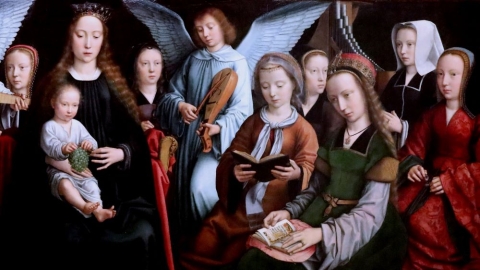The Fullness of Grace in Mary

Sacred Scripture has preciously preserved for us the Angel Gabriel’s salutation to the Virgin Mary at the Annunciation. In two short phrases it tells us all: “Hail, full of grace, the Lord is with thee.” (Lk. 1:28)
Drawing upon this treasure, Pope Pius IX described this fullness of grace for us when defining Mary’s Immaculate Conception: “Therefore, far above all the angels and all the saints so wondrously did God endow her with the abundance of all heavenly gifts poured from the treasury of His divinity… and a fullness of holy innocence and sanctity than which, under God, one cannot even imagine anything greater. (Bull Ineffabilis Deus).
Pius IX’s definition confirms Mary’s exceptional sanctity from the moment of her conception. It is a truth of Faith that the Mother of God had the fullness of grace, a fullness far greater than any other creature.
Based on what St. Thomas says (III, 7; 27,5) of Christ’s sacred humanity, we can put forth the following two arguments:
1. The closer a being is to the cause of an effect, the more fitting it is that it should receive this effect abundantly. Now Christ is the principle of habitual grace (as God, insofar as He is the absolutely first principle, as man, insofar as He is the instrument of God), and Mary is the person closest to Christ. It was therefore fitting that Mary should receive the greatest fullness of grace.
2. It is fitting that anyone who communicates grace should have habitual grace. Mary communicates grace (as mediatrix). It is therefore fitting that she should have a high degree of habitual grace.
What is this fullness?
The question is raised when speaking of the Word Incarnate, and allows for two distinctions (III, 7, 9-11).
Grace is a gift of God that is inserted in us and transforms us
This transformation can be more or less radical, more or less intense, just as heat is more or less strong in a body heated by fire.
This change also gives us the ability to act in a new way. The grace received disposes us to varying degrees to act, it embraces a varying number of supernatural actions: it’s extent more or less vast.
Fullness of grace can be found in either case.
This plenitude can be perfect, or it can be imperfect
If it is perfect, it is absolute fullness. It has no limit.
But if it is limited by the capacity of the one who receives it, it is imperfect, relative. God gives it to the extent to which it can be received, to the extent to which it is necessary to His divine plan.
According to St. Thomas, the possession of grace in its absolute fullness, both in intensity and in extent, belongs only to Christ. Our Lady therefore had a relative fullness of grace (cf. III, 27, 5 ad 1), in other words, all the grace necessary to be a worthy Mother of God.
As this mission was the most noble of all missions, due to its implication in the accomplishment of the Incarnation, it is the greatest relative fullness of grace ever conferred on a human or an angel.
Sanctifying grace makes us adopted children of God. This is the case for the Blessed Virgin Mary. And adoption gives a right to inheritance, Heaven, possessed according to the degree of charity at the moment of death. Our Lady’s charity was the greatest after that of Christ, and she therefore has the highest degree of glory in Heaven.
Lastly, Christ is not the adopted son of the Father, for He is His natural Son from all eternity (III, 23, 4). The two are incompatible. And for this reason, in the order of adoptive filiation, Our Lady holds the first place. She is the first adopted daughter of God.
Related links
Illustration : Flickr / lisabelle3 (CC BY-NC-ND 2.0)





